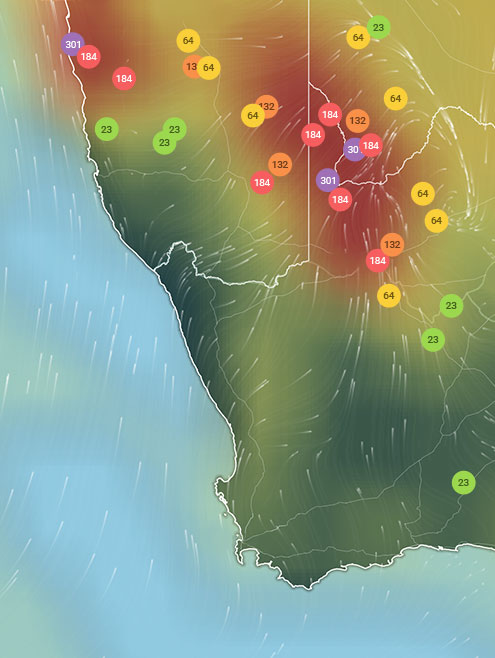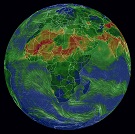Get a monitor and contributor to air quality data in your city.
8.3K people follow this city






AIR QUALITY DATA CONTRIBUTORS
Find out more about contributors and data sources| Weather | Clear sky |
| Temperature | 82.4°F |
| Humidity | 76% |
| Wind | 9.3 mp/h |
| Pressure | 29.7 Hg |
| # | city | US AQI |
|---|---|---|
| 1 | Uttaradit, Uttaradit | 156 |
| 2 | Chiang Mai, Chiang Mai | 152 |
| 3 | Doi Saket, Chiang Mai | 130 |
| 4 | San Sai, Chiang Mai | 128 |
| 5 | Chiang Rai, Chiang Rai | 122 |
| 6 | Mae On, Chiang Mai | 120 |
| 7 | Mae Mo, Lampang | 115 |
| 8 | Phetchabun, Phetchabun | 112 |
| 9 | Phitsanulok, Phitsanulok | 107 |
| 10 | Sukhothai, Sukhothai | 105 |
(local time)
SEE WORLD AQI RANKING
| # | station | US AQI |
|---|---|---|
| 1 | Lealawadee-Malee Garden | 63 |
| 2 | The Juniper Tree | 41 |
(local time)
SEE WORLD AQI RANKINGUS AQI
55
live AQI index
Moderate
| Air pollution level | Air quality index | Main pollutant |
|---|---|---|
| Moderate | 55 US AQI | PM2.5 |
| Pollutants | Concentration | |
|---|---|---|
| PM2.5 | 14µg/m³ | |
PM2.5
x2.8
PM2.5 concentration in Sam Roi Yot is currently 2.8 times the WHO annual air quality guideline value
| Sensitive groups should reduce outdoor exercise | |
| Close your windows to avoid dirty outdoor air GET A MONITOR | |
| Sensitive groups should wear a mask outdoors GET A MASK | |
| Sensitive groups should run an air purifier GET AN AIR PURIFIER |
| Day | Pollution level | Weather | Temperature | Wind |
|---|---|---|---|---|
| Wednesday, Apr 24 | Moderate 67 AQI US | 91.4° 78.8° | ||
| Thursday, Apr 25 | Moderate 58 AQI US | 89.6° 78.8° | ||
| Friday, Apr 26 | Moderate 63 AQI US | 91.4° 78.8° | ||
| Today | Moderate 55 AQI US | 91.4° 78.8° | ||
| Sunday, Apr 28 | Moderate 52 AQI US | 93.2° 80.6° | ||
| Monday, Apr 29 | Moderate 52 AQI US | 93.2° 78.8° | ||
| Tuesday, Apr 30 | Moderate 56 AQI US | 93.2° 78.8° | ||
| Wednesday, May 1 | Moderate 61 AQI US | 93.2° 78.8° | ||
| Thursday, May 2 | Moderate 58 AQI US | 91.4° 78.8° | ||
| Friday, May 3 | Moderate 56 AQI US | 93.2° 80.6° |
Interested in hourly forecast? Get the app
Observing the levels of air pollution in the form of US AQI towards the end of November 2021, it can be seen that Sam Roi Yot presented with a reading of 67, placing it into the 'moderate' air quality rating bracket. Whilst this is not dangerously high, it may still present some health issues for more vulnerable members of the population in Sam Roi Yot, with the PM2.5 reading also showing levels that were four times higher than the WHO's air quality guideline for exposure. Highs of 108 and 116 were seen around the same period, as well as lows of 37, indicating that the US AQI readings were fluctuating between 'good' ratings (0 to 50 on the US AQI scale) all the way up to 'unhealthy for sensitive groups' (101 to 150).
Continuous exposure to elevated levels of pollution in the air in Sam Roi Yot can cause a large number of dangerous and highly adverse health conditions to occur, being of particular prominence to certain individuals who are part of the sensitive group demographic, which will be covered in slightly more detail at the end of the article in the final question. Despite certain groups being more at risk, it is a common factor that even healthy or physically fit adults may find themselves subject to the negative side-effects of polluted air in Sam Roi Yot, particularly if this exposure is of a higher magnitude or takes place over a longer period, a factor that may be very important to note for those that find themselves living near to much more highly polluted areas such as industrial districts or near busy roads, whereby the air quality will be poorer, and hazardous particles more prevalent in the atmosphere for much of the year. A higher number of ailments that can present themselves amongst inhabitants, as a result, would be the standard shorter-term ones such as dry throat and coughs, as well as the accompanying chest pains and mild infections of the respiratory tract. These will typically resolve themselves in a relatively short amount of time when the exposure to air pollution is stopped, or at the very least reduced. As such, they can be classified as more acute health issues amongst possible health problems present in Sam Roi Yot. With continuous air pollution exposure taking place, respiratory aggravation may also develop into more long-term, chronic health problems. The continuous chest infections sustained as well as the accompanying coughing can lead to the scarring of lung tissue, which can result in a significantly (and often permanent) decreased lung capacity. As well as this, the scarring or damage and inflammation to the tissue of the lungs can make one more vulnerable to a whole host of respiratory distress, with chronic obstructive pulmonary disease (COPD) presenting itself. This is an umbrella term that refers to a multitude of different lung and respiratory tract conditions, typically resulting in shortness of breath as well as making an individual at greater risk of severe damage from pollution exposure. Some further conditions that fall under the COPD bracket are one such as pneumonia, bronchitis, emphysema as well as asthma. Other forms of damage that can happen within the body include increased risk of cancer, heart attacks, strokes and arrhythmias, as well as ischemic heart disease and many other cardiac or pulmonary conditions that can bring about decreased quality of life as well as lower life expectancy in Sam Roi Yot.
The main forms of air pollution found in Sam Roi Yot are those that can be found in the US AQI aggregation, which includes PM10 and PM2.5, the two main forms of particle pollution. Out of both of these, PM2.5 is the far more dangerous of the two, with its size of 2.5 micrometers or less in diameter making it able to bypass all of the body’s natural defense systems and penetrate deep into the tissue of the lungs, leading to some further health complications that will be discussed more at length in the next question regarding health problems caused by pollution exposure in Sam Roi Yot. Other pollutants forming the US AQI figure are sulfur dioxide, nitrogen dioxide (both of which are commonly released from vehicles, with nitrogen dioxide being found very prominently in the atmosphere over areas that see higher levels of traffic, with the two often having a strong correlation). Others include carbon monoxide and ozone, or smog as it is more commonly known when found on the ground level. Other pollutants of note are ones such as volatile organic compounds (VOCs), chemicals that can maintain a gaseous state even at lower temperatures and thus are much easier to breathe, due to their volatile nature. Some examples of VOCs are toluene, xylene, methylene chloride, benzene, styrene and formaldehyde. It is pertinent to be aware that VOCs are among the most common forms of indoor or household pollution, often being emitted from materials such as paints, varnishes, glues, as well as many other household items such as scented candles, aerosols or other various scented toiletry products.
Human-based or anthropogenic activity is one of the major contributing factors to elevated pollution levels in Sam Roi Yot, with the mass use of vehicles being among the issues. Traffic jams and areas that see a gathering of vehicles may lead to larger amounts of hazardous particulate matter and other pollutants being released into the atmosphere. Additionally, the continued use of vehicles over long periods can lead to large amounts of microscopic rubber particles entering the atmosphere, as well as contaminating soil or bodies of water. The gradual wear and tear of tire treads from the many vehicles in use lead to the release and buildup of tons of this dangerous material, which can have significantly detrimental effects on the health of those who are exposed to it in the air, as well as having adverse effects on the environment and various ecosystems. Other factors that contribute to elevated pollution levels in Sam Roi Yot, in particular nearer the end of the year are open burn sites or slash and burn farming practices. Whilst Sam Roi Yot is not subject to the extreme side of this problem due to its geographic location, it may see mild pollution elevation during the latter part of the year when said burning takes place, and as such caution should be taken during these times. Keeping up to date on air quality readings can be of great assistance in knowing when to utilize preventative measures such as wearing fine particle filtering masks or avoiding outdoor activities.
Groups that should take extra care to reduce their exposure levels are ones such as younger children and babies, as well as pregnant women. Those with pre-existing health conditions or poor immune systems should also take care with their exposure levels, as any conditions that one currently has can be greatly worsened by breathing smoke and other hazardous pollutants in the air.
2Contributors
Non-profit organization Contributor

1 station
Individual Contributor
1 station
1 Data source